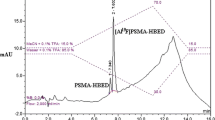Abstract
Auger-emitting radionuclides such as 99mTc have been the focus of recent studies aiming at finding more selective therapeutic approaches. To explore the potential usefulness of 99mTc as an Auger emitter, we have synthesized and biologically evaluated novel multifunctional structures comprising (1) a pyrazolyl-diamine framework bearing a set of donor atoms to stabilize the [M(CO)3]+ (M is Re, 99mTc) core; (2) a DNA intercalating moiety of the acridine orange type to ensure close proximity of the radionuclide to DNA and to follow the internalization and subcellular trafficking of the compounds by confocal fluorescence microscopy; and (3) a bombesin (BBN) analogue of the type X-BBN[7-14] (where X is SGS, GGG) to provide specificity towards cells expressing the gastrin releasing peptide receptor (GRPr). Of the evaluated 99mTc complexes, Tc 3 containing the GGG-BBN[7-14] peptide showed the highest cellular internalization in GRPr-positive PC3 human prostate tumor cells, presenting a remarkably high nuclear uptake in the same cell line. Live-cell confocal imaging microscopy studies with the congener Re complex, Re 3, showed a considerable accumulation of fluorescence in the nucleus, with kinetics of uptake similar to that exhibited by Tc 3. Together, these data show that the acridine orange intercalator and the metal fragment are colocalized in the nucleus, which indicates that they remain connected despite the lysosomal degradation of Tc 3/Re 3. These compounds are the first examples of 99mTc bioconjugates that combine specific cell targeting with nuclear internalization, a crucial issue to explore use of 99mTc in Auger therapy.
Graphical abstract
Pyrazolyl-diamine Re/99mTc tricarbonyl complexes bearing an acridine orange intercalator and bombesin peptides internalize and target the nucleus of gastrin releasing peptide receptor positive PC3 human prostate tumor cells.







Similar content being viewed by others
References
Adam MJ, Wilbur DS (2005) Chem Soc Rev 34:153–163
Kassis AI, Walicka MA, Adelstein SJ (2000) Acta Oncol 39:721–726
Stepanek J, Ilvonen SA, Lampinen JS, Savolainen SE, Välimäki PJ, Kuronun AA (2000) Acta Oncol 39:667–671
Chen P, Wang J, Hope K, Jin L, Dick J, Cameron R, Brandwein J, Minden M, Reilly RM (2006) J Nucl Med 47:827–836
Edel S, Terrissol M, Peudon A, Kümmerle E, Pomplun E (2006) Radiat Prot Dosim 122:136–140
Ickenstein LM, Edwards K, Sjöberg S, Carlsson J, Gedda L (2006) Nucl Med Biol 33:773–783
Michel RB, Rosario AV, Andrews PM, Foldenberg DM, Mattes MJ (2005) Clin Cancer Res 11:777–786
Bailey KE, Constantini DL, Cai Z, Scolland DA, Chen Z, Reilly RM, Vallis KA (2007) J Nucl Med 48:1562–1570
Häfliger P, Agorastos N, Spingler B, Georgiev O, Viola G, Alberto R (2005) ChemBioChem 6:414–421
Agorastos N, Borsig L, Renard A, Antoni P, Viola G, Spingler B, Kurz P, Alberto R (2007) Chem Eur J 13:3842–3852
Zelenka K, Borsig L, Alberto R (2011) Org Biomol Chem 9:1071–1078
Schipper ML, Riese CG, Seitz S, Weber A, Behe M, Schurrat T, Schramm N, Keil B, Alfke H, Behr TM (2007) Eur J Nucl Med Mol Imaging 34:638–650
Chan CR, Cai ZL, Su RF, Reilly RM (2010) Nucl Med Biol 37:105–115
Vitor RF, Correia I, Videira M, Marques F, Paulo A, Pessoa JC, Viola G, Martins GG, Santos I (2008) ChemBioChem 9:131–142
Vitor RF, Esteves T, Marques F, Raposinho P, Paulo A, Rodrigues S, Rueff J, Casimiro S, Costa L, Santos I (2009) Cancer Biother Radiopharm 24:551–563
Esteves T, Xavier C, Gama S, Mendes F, Raposinho PD, Marques F, Paulo A, Pessoa JC, Rino J, Viola G, Santos I (2010) Org Biomol Chem 8:4104–4116
Smith CJ, Volkert WA, Hoffman TJ (2005) Nucl Med Biol 33:733–740
Perrin DD, Armarego WL (1988) Purification of laboratory chemicals, 3rd edn. Pergamon Press, Oxford
Lazarova N, James S, Babich J, Zubieta J (2004) Inorg Chem Commun 7:1023–1026
Moura C, Esteves T, Gano L, Raposinho PD, Paulo A, Santos I (2010) New J Chem 34:2564–2578
Merrifield RB (1985) J Am Chem Soc 85:2149–2154
Alves S, Paulo A, Correia JDG, Gano L, Smith CJ, Hoffman TJ, Santos I (2005) Bioconjug Chem 16:438–449
Troutner DE, Volkert WA, Hoffman TJ, Holmes RA (1984) Int J Appl Radiat Isot 35:467–470
Abney JR, Cutler B, Fillbach ML, Axelrod D, Scalettar BA (1997) J Cell Biol 137:1459–1468
Smith CJ, Sieckman GL, Owen NK, Hayes DL, Mazuru DG, Kannan R, Volkert WA, Hoffman TJ (2003) Cancer Res 63:4082–4088
Vogt W (1995) Free Radic Biol Med 18:93–105
Smith CJ, Gali H, Sieckman GL, Higginbotham C, Volkert WA, Hoffman TJ (2003) Bioconjug Chem 14:93–102
Zhang H, Chen J, Waldherr C, Hinni K, Waser B, Reubi JC, Maecke HR (2004) Cancer Res 64:6707–6751
Vigna SR (1989) Biol Bull 177:192–194
Alves S, Correia JDG, Santos I, Veerendra B, Sieckman GL, Hoffman TJ, Rold TL, Figueroa SD, Retzloff L, McCrate J, Prasanphanich A, Smith CJ (2006) Nucl Med Biol 33:625–634
Acknowledgments
T.E. thanks the FCT for a doctoral research grant (SFRH/BD/29154/2006). COST Action D39 is also acknowledged. The quadruple ion trap mass spectrometer was acquired with the support of the Programa Nacional de Reequipamento Científico (contract REDE/1503/REM/2005-ITN) of Fundação para a Ciência e a Tecnologia and is part of Rede Nacional de Espectrometria de Massa (RNEM).
Author information
Authors and Affiliations
Corresponding author
Electronic supplementary material
Below is the link to the electronic supplementary material.
Rights and permissions
About this article
Cite this article
Esteves, T., Marques, F., Paulo, A. et al. Nuclear targeting with cell-specific multifunctional tricarbonyl M(I) (M is Re, 99mTc) complexes: synthesis, characterization, and cell studies. J Biol Inorg Chem 16, 1141–1153 (2011). https://doi.org/10.1007/s00775-011-0803-x
Received:
Accepted:
Published:
Issue Date:
DOI: https://doi.org/10.1007/s00775-011-0803-x




